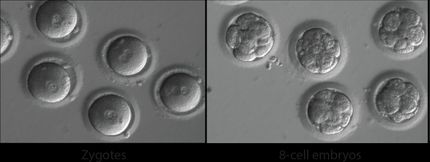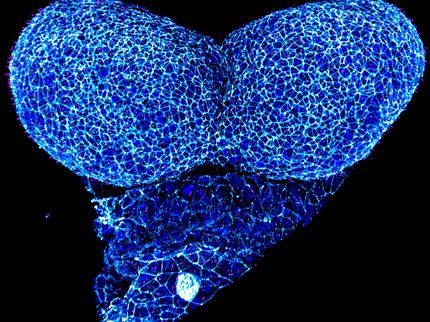Scientists identify gene behind rare childhood syndrome
Thanks in part to the efforts of one dedicated mother, who took to Facebook to document her son’s mysterious developmental disability, an international team of researchers led by scientists at UC San Francisco and Baylor College of Medicine in Houston has now identified a new genetic syndrome that could help illuminate the biological causes of one of the most common forms of intellectual disability.
In a study of 10 children the researchers linked a constellation of birth defects affecting the brain, eye, ear, heart and kidney to mutations in a single gene, called RERE. The discovery is likely to aid researchers striving to understand the cause of birth defects more broadly, the study’s authors said, but it is also a boon to families who know for the first time the reason their children share this group of developmental disabilities.
“Just having an answer can be hugely beneficial for families,” said co-senior author Elliott Sherr , MD, PhD, a UCSF pediatric neurologist who directs the Brain Development Research Program and the Comprehensive Center for Brain Development at UCSF. “Of course, getting a genetic answer is just the first step, but for the longest time we didn’t even have that much. It gives these families hope that we can move forward.”
Finding Could Speed Search for Answers in More Common Genetic Syndrome
In their paper, the researchers demonstrate that the developmental disabilities suffered by children with RERE mutations correspond almost perfectly to the well-known pattern of intellectual disabilities, heart defects, craniofacial abnormalities, and hearing and vision problems seen in 1p36 deletion syndrome, one of the most common sources of intellectual disability in children. This syndrome occurs in approximately 1 in 5,000 newborns, and is caused by a much larger (and harder to study) pattern of genetic damage in the so-called 1p36 region at the tip of human chromosome 1.
The research group of Daryl Scott, MD, PHD, an associate professor of molecular and human genetics at Baylor College of Medicine, has been working for many years to identify the specific genes that cause the medical problems in children with 1p36 deletion syndrome. “Previous research had narrowed it down to two smaller ‘critical regions’ within the 1p36 region, but even these smaller regions contain dozens of different genes,” said Scott, who was co-senior author on the new study.
Scott’s group had focused on the RERE gene, which lies within one of these 1p36 critical regions, because it plays a role in retinoic acid (vitamin A) signaling, an important pathway regulating the development of many organs, including the brain, eye and heart. The Baylor researchers found that mice with Rere mutations had birth defects that were very similar to the children with 1p36 deletions, but had initially been unable to prove that damage to this gene was sufficient produce the same developmental problems in humans.
A Mother’s Activism Spurs a Research Breakthrough
Sherr and Scott credit the genesis of their collaboration to Chauntelle Trefz, the mother of one of Sherr’s patients who connected the two researchers after discovering Scott’s work on mice with Rere mutations online and whose Facebook page about her son, Harrison, became a hub for identifying other children with the same condition.
Trefz says that getting the whole exome sequencing results from Sherr and learning that a single gene mutation was responsible for her son’s dizzying array of symptoms — which include global developmental delay, vision problems, hearing problems, weak muscles, and constant acid reflux — was “a game-changer.”
“Learning about the mutation was like a huge weight had been lifted,” she said. “When you bring a child with special needs into the world you feel so guilty, like you’ve done something wrong. Hope can be a hard thing to find. Dr. Sherr gave us hope.”
Trefz started a Facebook page documenting the joys and challenges of raising and caring for Harrison, who is now 4, hoping to find other families whose children had the same condition. “Harrison is such a happy kid, and he seems normal in many ways, but he’s really not,” she said. “I could see a lot of kids falling through the cracks without the right diagnosis. I wanted other parents to see this and say, ‘that sounds like my son.’”
Soon Sherr and Scott had identified 10 children with RERE mutations through collaborators around the US, as well as several from the Netherlands who had found the researchers through Trefz’s Facebook page. The researchers began a thorough comparison of these 10 children with a cohort of 31 patients with the more common 1p36 deletion syndrome, and found that RERE mutations alone produced almost exactly the same pattern of symptoms as 1p36 syndrome, with the exception of a few of the craniofacial abnormalities and cardiomyopathies often seen in that more common syndrome. Additional experiments showed that unique brain and eye problems first observed in human patients were also seen in the mice with Rere mutations.
“It’s still a shock that [a mutation in] one gene is capable of causing all these different problems,” Scott said. “But this finding really brings everything together, from molecular studies to mouse experiments and all the way to human patients. We’ve finally proved what we’ve been talking about for all these years.”
Though much more study is needed to understand the syndrome fully, Scott said, RERE mutations may be capable of inducing a diverse set of developmental problems because the protein encoded by the gene interacts with important developmental processes in many organs throughout the body, such as the retinoic acid signaling crucial for proper eye and heart development. When RERE doesn’t function properly, the development of all of these organs is affected.
Sherr acknowledges that the current sample of just 10 patients with RERE mutations, who each experience slightly different symptoms with notably different levels of severity, is too small to give a complete portrait of the new syndrome.
“Now that we’ve seen the first 10 cases, we want to know what the next 10, the next 20 look like,” he said. “That may not take very long. Before we’d even published the paper, we’d already gotten calls from more clinics around the country whose patients have similar mutations. We suspect this syndrome may be significantly more common than we previously appreciated.”
The empowerment of families through social media and the plummeting cost of of gene sequencing technologies have produced a revolution in the pace of discovery about rare genetic conditions, Sherr said.
“In the last five years alone there’s been a huge explosion in the number of conditions we can decipher genetically – we can take a few kids with developmental disabilities, come up with a coherent genetic explanation for what has happened and use that as first step for how to move forward” he said. “When I started working in child neurology as a fellow back in the late ‘90s, we understood just a few of these super-rare genetic disorders but now there are hundreds. And we’re just getting started.”




















































